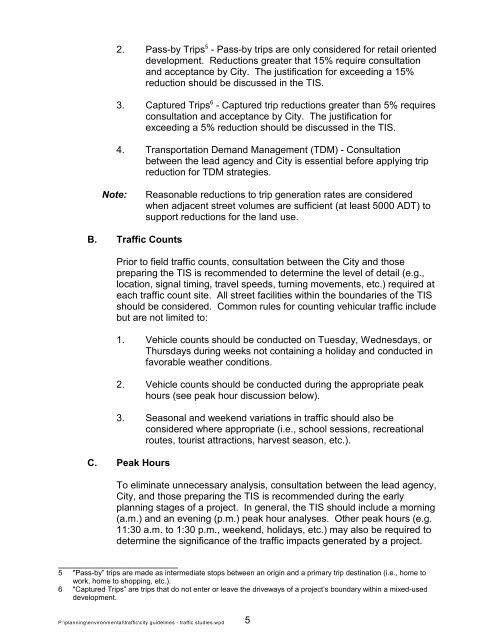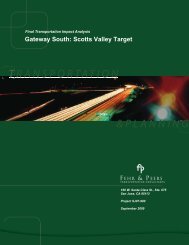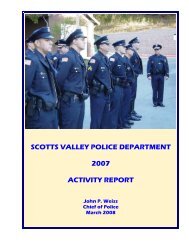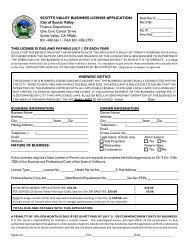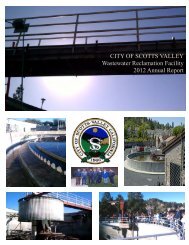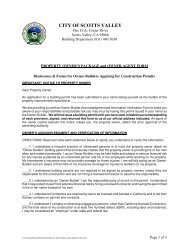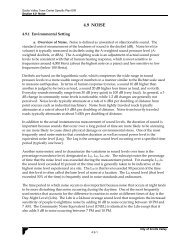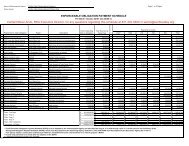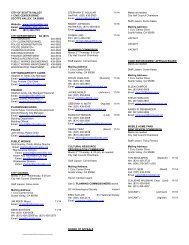Guide to Traffic Impact Study - City of Scotts Valley
Guide to Traffic Impact Study - City of Scotts Valley
Guide to Traffic Impact Study - City of Scotts Valley
You also want an ePaper? Increase the reach of your titles
YUMPU automatically turns print PDFs into web optimized ePapers that Google loves.
5<br />
2. Pass-by Trips - Pass-by trips are only considered for retail oriented<br />
development. Reductions greater that 15% require consultation<br />
and acceptance by <strong>City</strong>. The justification for exceeding a 15%<br />
reduction should be discussed in the TIS.<br />
6<br />
3. Captured Trips - Captured trip reductions greater than 5% requires<br />
consultation and acceptance by <strong>City</strong>. The justification for<br />
exceeding a 5% reduction should be discussed in the TIS.<br />
4. Transportation Demand Management (TDM) - Consultation<br />
between the lead agency and <strong>City</strong> is essential before applying trip<br />
reduction for TDM strategies.<br />
Note:<br />
Reasonable reductions <strong>to</strong> trip generation rates are considered<br />
when adjacent street volumes are sufficient (at least 5000 ADT) <strong>to</strong><br />
support reductions for the land use.<br />
B. <strong>Traffic</strong> Counts<br />
Prior <strong>to</strong> field traffic counts, consultation between the <strong>City</strong> and those<br />
preparing the TIS is recommended <strong>to</strong> determine the level <strong>of</strong> detail (e.g.,<br />
location, signal timing, travel speeds, turning movements, etc.) required at<br />
each traffic count site. All street facilities within the boundaries <strong>of</strong> the TIS<br />
should be considered. Common rules for counting vehicular traffic include<br />
but are not limited <strong>to</strong>:<br />
1. Vehicle counts should be conducted on Tuesday, Wednesdays, or<br />
Thursdays during weeks not containing a holiday and conducted in<br />
favorable weather conditions.<br />
2. Vehicle counts should be conducted during the appropriate peak<br />
hours (see peak hour discussion below).<br />
3. Seasonal and weekend variations in traffic should also be<br />
considered where appropriate (i.e., school sessions, recreational<br />
routes, <strong>to</strong>urist attractions, harvest season, etc.).<br />
C. Peak Hours<br />
To eliminate unnecessary analysis, consultation between the lead agency,<br />
<strong>City</strong>, and those preparing the TIS is recommended during the early<br />
planning stages <strong>of</strong> a project. In general, the TIS should include a morning<br />
(a.m.) and an evening (p.m.) peak hour analyses. Other peak hours (e.g.<br />
11:30 a.m. <strong>to</strong> 1:30 p.m., weekend, holidays, etc.) may also be required <strong>to</strong><br />
determine the significance <strong>of</strong> the traffic impacts generated by a project.<br />
______________________<br />
5 "Pass-by” trips are made as intermediate s<strong>to</strong>ps between an origin and a primary trip destination (i.e., home <strong>to</strong><br />
work, home <strong>to</strong> shopping, etc.).<br />
6 "Captured Trips” are trips that do not enter or leave the driveways <strong>of</strong> a project’s boundary within a mixed-used<br />
development.<br />
P:\planning\environmental\traffic\city guidelines - traffic studies.wpd<br />
5


